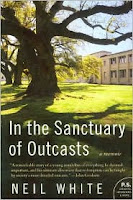 Welcome to Thrity Thursday, also known as "The Space Between Us" readalong. We'll be reading the book over the next five weeks. Thanks to these bloggers for joining me!
Welcome to Thrity Thursday, also known as "The Space Between Us" readalong. We'll be reading the book over the next five weeks. Thanks to these bloggers for joining me!Ti at Book Chatter
Dar at Peeking Between The Pages
Staci at Life In The Thumb
Kathy at Mommy's Reading
Booksync at Book In The City
Bailey at The Window Seat Reader
Mari at Bookworm With A View
Chapters 1-6
My Synopsis:
Bhima and her granddaughter, Maya, live in the slums of Bombay. They've had to move there after Bhima's husband, Gopal, leaves her but Bhima had high hopes for Maya, who was going to college. But Maya is pregnant and Bhima is both angry and afraid; she can't let herself comfort Maya in anyone because she needs Maya to understand the shame this will bring on them.
Bhima has worked as a housekeeper for Sera Dubash, who also lives with her daughter Dinaz and son-in-law, Viraf. Dinaz is also pregnant. Sera likes to say that Bhima is one of the family but still treats her like a lower-class citizen. They have tea together, but Bhima isn't allowed to sit on a chair. On the other hand, it's Sera that saw the potential in Maya and has taken care of her education.
Even though Sera and Bhima believe that Maya should have an abortion, Bhima holds on to the hope that Maya will name the father of her baby and that he will do the honorable thing and Maya will make a good marriage. So when Maya finally gives Bhima a name, Bhima decides to find him at the college and confront him. But when she does, she discovers that Maya has lied; the boy she named hardly knows Maya and now word of Maya's pregnancy will spread over the campus, meaning that Maya cannot return.
Maya finally agrees to get an abortion but asks that Sera go with her rather than Bhima because she knows she will get better care if a woman of wealth is with her.
We also get some of the background of Sera when she visits the home of her mother-in-law, Banu, whom Sera calls "The Monster." Banu has suffered a stroke and is paralyzed; Sera visits her every day but pinches Banu's unfeeling cheek to prove a point. Banu treated her terribly when Sera and her husband, Feraz, lived with Banu and her husband, Freddy.
We also learn about Bhima's courtship with Gopal who pursued Bhima after meeting her at a cousin's wedding. When they marry he promises her a live of fun and that he will always treat her like a queen.
My Thoughts:
Well, then, that's a lot of names isn't it?! I'm thinking we've met almost everyone that's going to play a prominent part in this book. Classism is clearly going to be a huge theme here: Sera says she feels like Bhima is one of the family but clearly doesn't really feel that way; on more than one occasion the point is made that the wealthy will be treated better than the poor; even Bhima, who didn't always live in the slums, considers herself a step above the other residents because she doesn't feel like she belongs there.
"On the one hand, it makes her flush with pride when Serabai calls her "my Bhima" and talks about her proprietarily. On the other hand, she always seems to be doing things that undercut Bhima's interests. Life refusing Viraf baba's offer to buy a dishwasher. How nice it would be not to run her arthritic hands in water all day long."I'm thinking that much will be made, also, of the difference between Maya's and Dinaz's pregnancies.
Much like I was with Umrigar's "The Weigh of Heaven," I was pulled right into this book. Her descriptions of Bhima's life are almost painful to read--so raw that I can't even make myself give you a quote. I think I'm going to have a hard time doling this one out a few chapters a week! If you're interested in joining us, it's not too late.






































